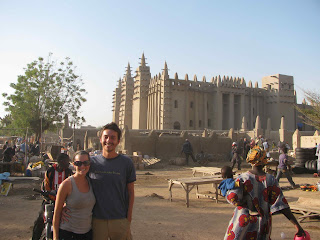On a small island cradled by the Niger, sits the city of Djenné, considered one of the most important cities in Muslim academia with people traveling from throughout the Islamic world to live and study here. After taking a barge across the Niger and crossing a precarious-looking mud bridge, our truck lumbered into the city, stirring up a cocoa-colored dust and scarcely squeezing past a number of the multi-story, mud buildings. We found our way to the roof of Le Campement and from there had a clear view of women bathing themselves with water pails, topless. Tick the box on another sight seen… Amy told us about a Nigerian writer who caustically wrote that every Western guide book of any African country must include a photo of women with bare breasts. While he was clearly pointing to a Western tendency to sensationalize and stereotype an entire continent of varied peoples, there’s no doubt it still catches you by surprise and suddenly reminds you of something important you forgot somewhere else.
The next day the whole group took tours through the city, starting with the highlight of the region: the Djenné mosque. As the largest mud building in the world, it’s impressive to behold. It needs to have additional layers spread on it every year to avoid melting into the ground. From the outside (entrance forbidden to non-Muslims) our guide described hundreds of pillars in the main foyer supporting the roof. Each pillar represents a distinct lesson for a person studying Islam and the last pillar’s meaning is known to only a privileged few. Later, we passed by the grave of the virgin girl buried alive as a sacrifice to bring good fortune to the city on its founding in the 11th century. Her family, we’re told, has reaped a tithe from every harvest since. Sounds like it worked out for everyone except the girl…
The city streets surrounding the mosque were filled with Islamic schools and children writing Arabic on clay tablets, some of whom would run up and grab our hands and then run away laughing. One of our tour guides confessed that he used to do the same to white tourists when he was little because he and his friends believed that it would make them turn whiter. To which Reena, the British-Indian eye doctor, later remarked, “Then why are they touching me?”
Lastly we wound through the Djenné market, boasted as one of Africa’s largest. Huge piles of dried fish didn’t entice us to take our wallets out, but we did buy some scarlet and white colored kola nuts. They’re naturally caffeinated (one of the original ingredients in Coca Cola) and have been used as currency throughout the region for centuries, particularly in the Dogon country where they are sometimes preferred over money. Our guide was happy to receive one as a gift at the end of the tour and happily chewed on it with the few teeth he had left. Probably better than giving him a Coke.





No comments:
Post a Comment